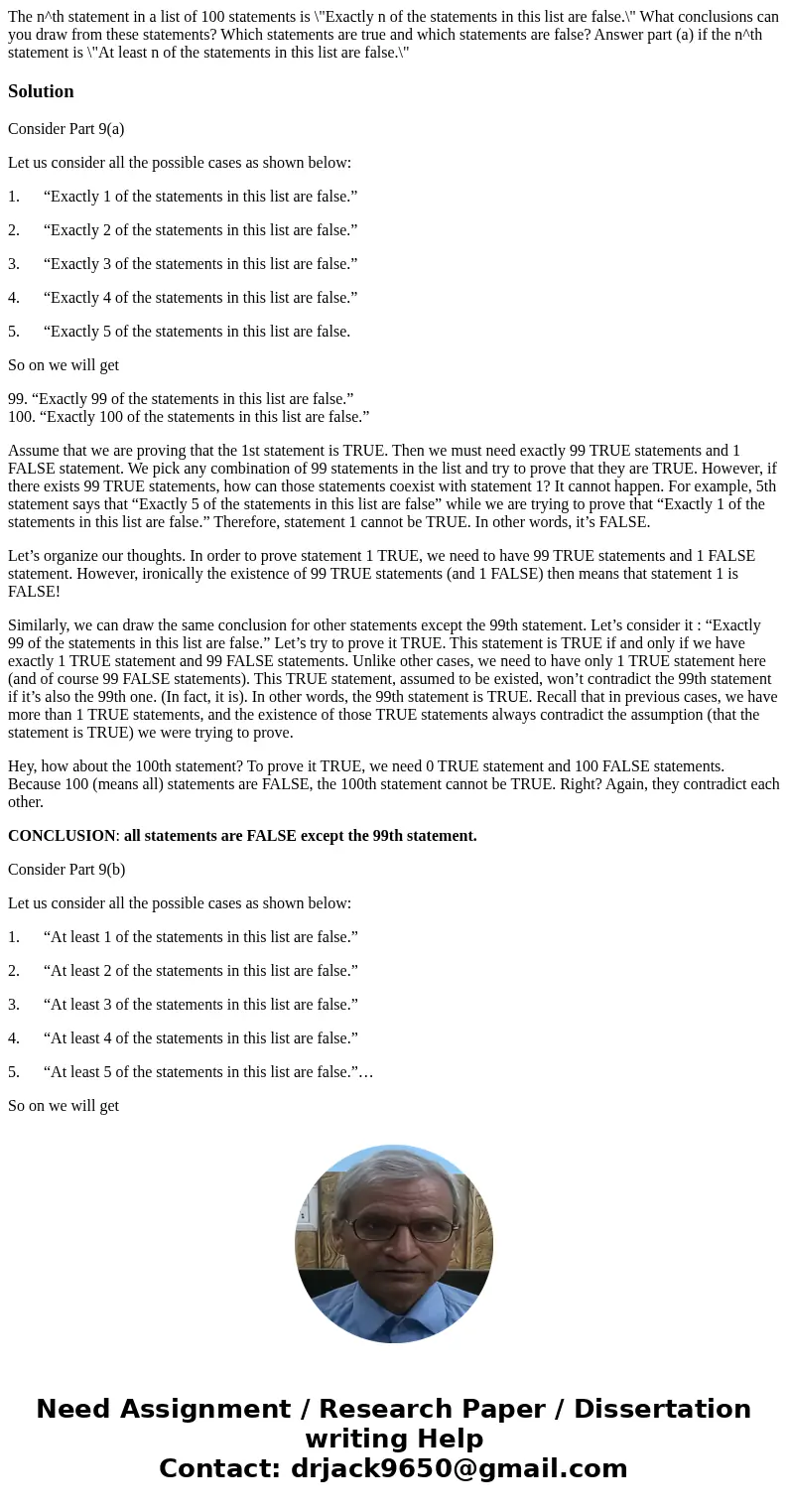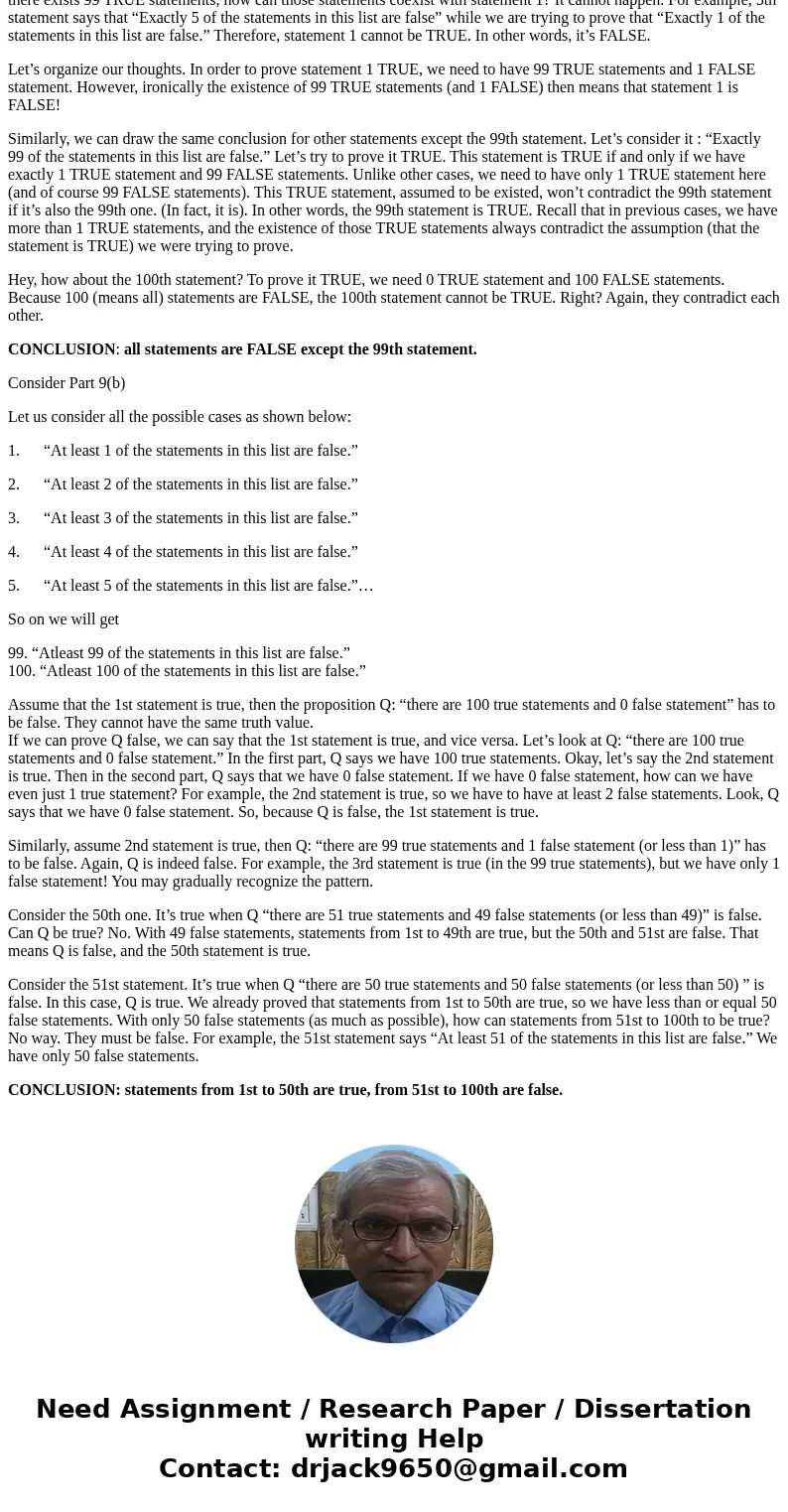The nth statement in a list of 100 statements is Exactly n o
Solution
Consider Part 9(a)
Let us consider all the possible cases as shown below:
1. “Exactly 1 of the statements in this list are false.”
2. “Exactly 2 of the statements in this list are false.”
3. “Exactly 3 of the statements in this list are false.”
4. “Exactly 4 of the statements in this list are false.”
5. “Exactly 5 of the statements in this list are false.
So on we will get
99. “Exactly 99 of the statements in this list are false.”
100. “Exactly 100 of the statements in this list are false.”
Assume that we are proving that the 1st statement is TRUE. Then we must need exactly 99 TRUE statements and 1 FALSE statement. We pick any combination of 99 statements in the list and try to prove that they are TRUE. However, if there exists 99 TRUE statements, how can those statements coexist with statement 1? It cannot happen. For example, 5th statement says that “Exactly 5 of the statements in this list are false” while we are trying to prove that “Exactly 1 of the statements in this list are false.” Therefore, statement 1 cannot be TRUE. In other words, it’s FALSE.
Let’s organize our thoughts. In order to prove statement 1 TRUE, we need to have 99 TRUE statements and 1 FALSE statement. However, ironically the existence of 99 TRUE statements (and 1 FALSE) then means that statement 1 is FALSE!
Similarly, we can draw the same conclusion for other statements except the 99th statement. Let’s consider it : “Exactly 99 of the statements in this list are false.” Let’s try to prove it TRUE. This statement is TRUE if and only if we have exactly 1 TRUE statement and 99 FALSE statements. Unlike other cases, we need to have only 1 TRUE statement here (and of course 99 FALSE statements). This TRUE statement, assumed to be existed, won’t contradict the 99th statement if it’s also the 99th one. (In fact, it is). In other words, the 99th statement is TRUE. Recall that in previous cases, we have more than 1 TRUE statements, and the existence of those TRUE statements always contradict the assumption (that the statement is TRUE) we were trying to prove.
Hey, how about the 100th statement? To prove it TRUE, we need 0 TRUE statement and 100 FALSE statements. Because 100 (means all) statements are FALSE, the 100th statement cannot be TRUE. Right? Again, they contradict each other.
CONCLUSION: all statements are FALSE except the 99th statement.
Consider Part 9(b)
Let us consider all the possible cases as shown below:
1. “At least 1 of the statements in this list are false.”
2. “At least 2 of the statements in this list are false.”
3. “At least 3 of the statements in this list are false.”
4. “At least 4 of the statements in this list are false.”
5. “At least 5 of the statements in this list are false.”…
So on we will get
99. “Atleast 99 of the statements in this list are false.”
100. “Atleast 100 of the statements in this list are false.”
Assume that the 1st statement is true, then the proposition Q: “there are 100 true statements and 0 false statement” has to be false. They cannot have the same truth value.
If we can prove Q false, we can say that the 1st statement is true, and vice versa. Let’s look at Q: “there are 100 true statements and 0 false statement.” In the first part, Q says we have 100 true statements. Okay, let’s say the 2nd statement is true. Then in the second part, Q says that we have 0 false statement. If we have 0 false statement, how can we have even just 1 true statement? For example, the 2nd statement is true, so we have to have at least 2 false statements. Look, Q says that we have 0 false statement. So, because Q is false, the 1st statement is true.
Similarly, assume 2nd statement is true, then Q: “there are 99 true statements and 1 false statement (or less than 1)” has to be false. Again, Q is indeed false. For example, the 3rd statement is true (in the 99 true statements), but we have only 1 false statement! You may gradually recognize the pattern.
Consider the 50th one. It’s true when Q “there are 51 true statements and 49 false statements (or less than 49)” is false. Can Q be true? No. With 49 false statements, statements from 1st to 49th are true, but the 50th and 51st are false. That means Q is false, and the 50th statement is true.
Consider the 51st statement. It’s true when Q “there are 50 true statements and 50 false statements (or less than 50) ” is false. In this case, Q is true. We already proved that statements from 1st to 50th are true, so we have less than or equal 50 false statements. With only 50 false statements (as much as possible), how can statements from 51st to 100th to be true? No way. They must be false. For example, the 51st statement says “At least 51 of the statements in this list are false.” We have only 50 false statements.
CONCLUSION: statements from 1st to 50th are true, from 51st to 100th are false.


 Homework Sourse
Homework Sourse